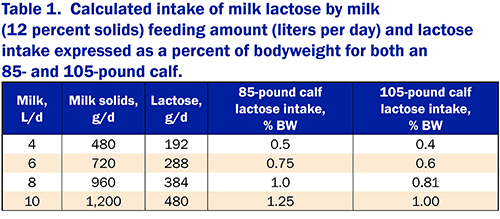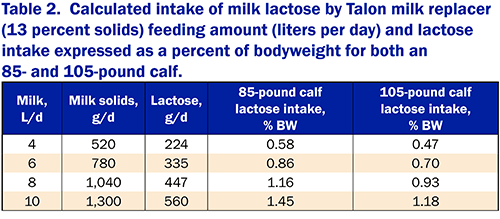
Lactose: Too Much of a Good Thing? – Dr. Noah Litherland, Vita Plus
 By Dr. Noah Litherland, Vita Plus dairy youngstock technical specialist
By Dr. Noah Litherland, Vita Plus dairy youngstock technical specialistCalves fed large volumes of milk at a young age tend to have more liquid and lighter-colored stools than calves fed more conservative amounts of milk. For some time now, I hypothesized that feeding excessive concentration or excessive amounts of lactose increases the risk of nutritional scours in young calves. A review of literature on lactose digestion helped shed light on the question, “Does excessive lactose feeding cause nutritional scours in young calves?”
Lactose, or milk sugar, is a disaccharide, meaning it consists of two sugars (glucose and galactose). Lactose is the primary carbohydrate found in milk and represents about 40 percent of milk solids in cows’ milk. Milk lactose concentration is very consistent throughout lactation. Lactose is an important component of milk and milk replacer for calves as a source of energy and a natural laxative.
Less is known about lactose digestion than protein or fat digestion in calves. We do know that, in all mammalian species studied, lactose alters the function of both the large and small intestine. Opportunities exist to better understand how milk lactose impacts calf health and growth.
Take-home notes from review of lactose literature (multiple species)
- Because of its slow digestion and absorption, lactose reaches the lower portion of the small intestine and the large intestine where it is fermented or passed out in feces.
- Excessive lactose feeding causes a large increase in urine galactose output.
- Excessive lactose intake elicits a shift in intestinal microbial ecology from a diverse population to a narrow population of bacteria tolerant of low pH (acidophilic organisms). Perhaps this shift in pH is one of the factors causing the hair loss on the rump, tail, and backs of legs of calves with severe nutritional scours.
- Excessive lactose intake causes a natural laxative effect, resulting in increased gastrointestinal motility. Undigested lactose causes an osmotic pull of water from blood into the lumen of the intestine. A decrease in pH of the intestine likely interferes with neutralization and absorption of organic acids, resulting in compounding digestive upset.
- Increased acidity of stool, increased fecal water, and decreased protein and fat digestion have been observed in infants overfed lactose.
- As calves age and bodyweight increases, the effects of excessive lactose feeding appear to decrease.
The laxative nature of lactose: Now this is starting to make some sense
Lactose increases intestinal motility (the rate of movement of digesta through the small and large intestine). This laxative effect is likely due to both the presence of lactose in the small intestine and a resultant shift in intestinal microbial ecology. Additional factors such as osmolality of milk (impacted by amount and composition of ash, and presence of bacteria) almost certainly contribute to the laxative effects.
Damaged intestinal epithelium can result in reduced mucosal enzyme activity, malabsorption and diarrhea. Intestinal lactase activity is one of the last functions to return to normal after mucosal damage. In the short-term, scours can at least decrease feed efficiency and decrease calf growth. In the long-term, scours can decrease gut barrier function and increase risk of respiratory disease.
Now that we have a better understanding of how excessive lactose feeding contributes to nutritional scours, what are we going to do about it?
Whole milk and milk replacer feeding rate and composition impacts lactose intake. Increasing the milk feeding rate from 6 to 8 quarts daily results in nearly a 0.25-pound increase in milk lactose intake. Milk replacer formulas typically have a greater lactose concentration than whole milk.
Milk replacer formulas consist of five primary nutrients: protein, fat, lactose, ash or minerals, and additives. The protein and fat content are listed on the tags and the ash content is listed on Vita Plus milk replacer tags. In general, it ranges from as low as 5 percent up to 10 percent. For example, a 20/20 milk replacer containing 6 percent ash also contains about 54 percent lactose. A 25/25 milk replacer with 6 percent ash contains about 44 percent lactose. Lactose in milk replacer can be approximated by difference using Equation 1.
Equation 1. Estimating lactose content in milk replacer.
% lactose = 100 – (% protein + % fat + % ash)
So, how much lactose is too much?
Based on field experience, we start to see nutritional scours when milk feeding rates are increased too quickly in calves at a young age. An estimated theoretical tipping point for nutritional scours associated with lactose intake for newborn calves is around 1.0 percent of bodyweight or around 385 grams of lactose per day (controlled research would need to be conducted to more accurately define a maximum threshold for lactose intake in calves).
Calves weighing 85 pounds would reach the tipping point when consuming about 8 liters of whole milk (Table 1). Calves that are a few weeks older and weigh 105 pounds can consume close to 9 liters of milk and be under the threshold for both lactose intake (grams per day) and expressed as a percent of bodyweight. Intakes of lactose from Talon milk replacer (25/25) are slightly higher than whole milk (Table 2) due to a 4-percent greater lactose concentration in Talon and slightly higher solids content than whole milk, but follows a similar trend.


Summary
- Excessive lactose feeding is likely one factor significantly impacting risk for calf scours.
- Milk hygiene (low bacteria count) and low ash content of milk replacer impact milk osmolality and almost certainly act additively to increase risk of nutritional scours with high-lactose feeding.
- Many other factors (pathogen load, hydration status, additional stressors) impact calf response to the amount of lactose fed.
- The amount of lactose overfeeding will likely impact the extent and duration of calf scours.
- Determine if overfeeding lactose is constraining your calf program.
| Category: |
Calf and heifer nutrition Starting Strong - Calf Care |

